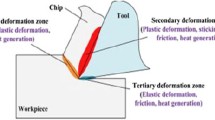Abstract
Ultra-precision machines are widely used to turn aspherical or spherical profiles on mould inserts for the injection moulding of optical lenses. During the turning of a profile on a stainless steel mould insert, the cutting speed reduces significantly to 0 as the cutting tool is fed towards the centre of the machined profile. This paper reports experiments carried out to study the wear of uncoated and PVD-coated carbide tools (carbide tool coated with 2000 alternate layers of AlN and TiN, each layer 1.5 nm and carbide tool coated with 0.5 μm TiN, 5.5 μm TiCN and 0.5 μm TiN) in the ultra-precision machining of STAVAX (modified AISI 420 stainless steel) at low speeds with and without lubricant. A sprayed mixture of compressed air, liquid paraffin oil and cyclomethicone was used as lubricant. Examination of the wear at the rake face of the tool suggests that during machining of the alloy with a hardness of 55 HRC without lubricant, the cutting edge is subjected to high compressive stress, resulting in fracture. Reducing the hardness of the alloy would therefore result in a lower stress acting on the cutting edge, thus rendering the tool less susceptible to fracture. Both the rake and the flank faces of the coated tools exhibited lower wear than the uncoated tools. This was due to the former tools possessing higher fracture resistance owing to the presence of the coating. The lubricant was effective in improving surface finish, preventing surface fracture and reducing flank wear.
Similar content being viewed by others
References
X. Ding, W. Y. H. Liew, B. K. A. Ngoi, J. G. K. Gan and S. H. Yeo, Tribol. Lett. 12 (2002) 3.
W. Y. H. Liew, B. K. A. Ngoi and Y. G. Lu, Wear 254 (2003) 265.
E. Paul, C. J. Evans and R. S. Polvant, in: Proceedings ASPE Spring Topical Meeting on Principles of Cutting Mechanics (1993) 88.
C. Evans, CIRP Ann. 40 (1991) 571.
E. O. Ezugwu and K. A. Olajire, Tribol. Letts. 12 (2002) 183.
A. Jawaid, K. A. Olajire and E. O. Ezugwu, Proc. Instn. Mech. Engrs 215 Part B (2001) 769.
S. Agrawal, A. K. Chakrabarti and A. B. Chattopadhyay, J. Mater. Process. Technol. 52 (1995) 610.
J. Paro, H. Ha¨ nninen and V. Kauppinen, J. Mater. Process. Technol. 119 (2001) 14.
L. Jiang, H. Ha¨ nninen, J. Paro and V. Kauppinen, Metall. Mater. Trans. 27A (1996) 2796.
E. M. Trent and P. K. Wright, Metal Cutting (Butterworth-Heinemann, 2000).
P. K. Wright, Metals Tech. 8 (1981) 150.
P. K. Wright and E. M. Trent, Metals Tech. 1 (1974) 13.
H. Chandrasekaran and D. V. Kapoor, J. Eng. Ind., Trans. ASME 87 (1965) 495.
H. Ren and Y. Altintas, J. Manuf. Sci. Eng., Trans. ASME, 122 (2000) 650.
M. M. Elkhabeery and J. A. Bailey, J. Eng. Mater. Technol., Trans. ASME 106 (1984) 152.
Author information
Authors and Affiliations
Rights and permissions
About this article
Cite this article
Liew, W., Lu, Y., Ding, X. et al. Performance of Uncoated and Coated Carbide Tools in the Ultra-Precision Machining of Stainless Steel. Tribology Letters 17, 851–857 (2004). https://doi.org/10.1007/s11249-004-8093-x
Issue Date:
DOI: https://doi.org/10.1007/s11249-004-8093-x




